-
1 of 253523 objects
Chest-of-drawers (commode), 1774
Oak and marquetry, gilt bronze, marble | 91.0 x 153.0 x 63.0 cm (whole object) | RCIN 21213
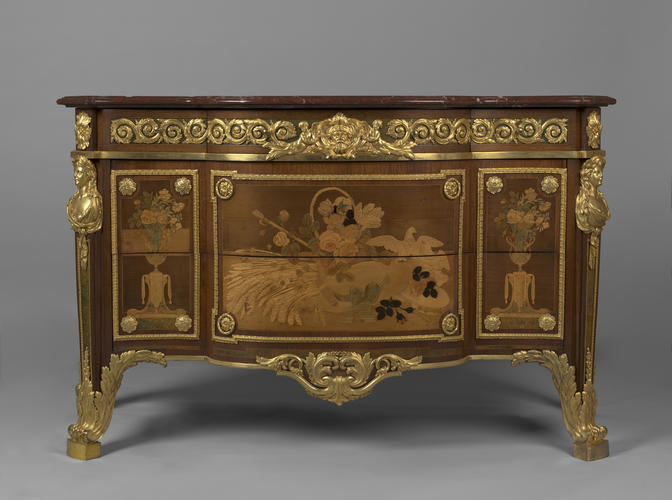
Jean-Henri Riesener (1734-1806)
21213 front low.tif 1774
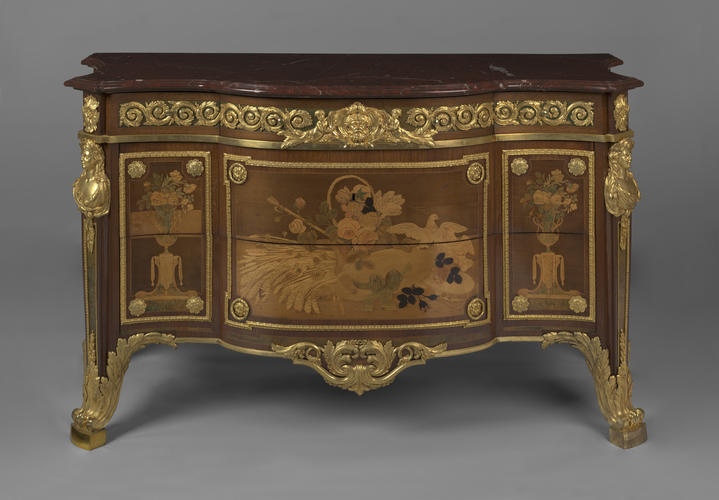
Jean-Henri Riesener (1734-1806)
21213 front high paper.tif 1774
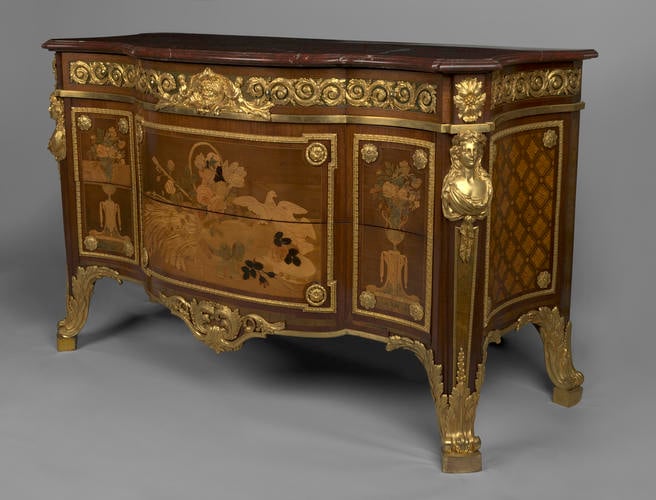
Jean-Henri Riesener (1734-1806)
21213 angle right paper.tif 1774
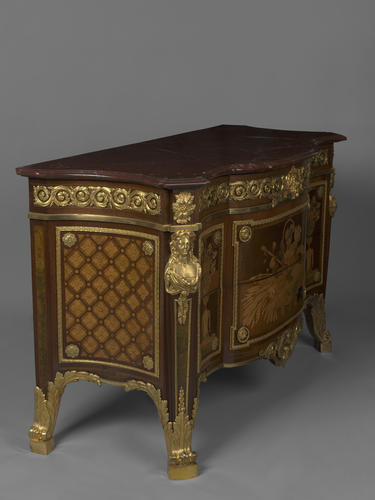
Jean-Henri Riesener (1734-1806)
21213 angle left paper.tif 1774
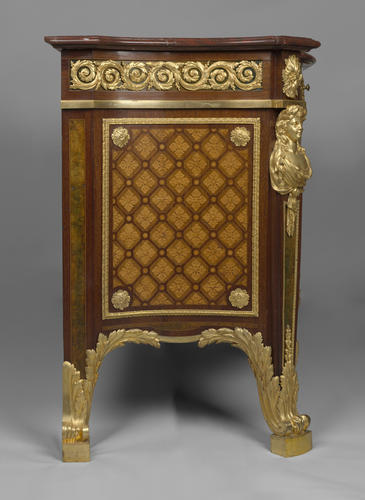
Jean-Henri Riesener (1734-1806)
21213 left side.tif 1774
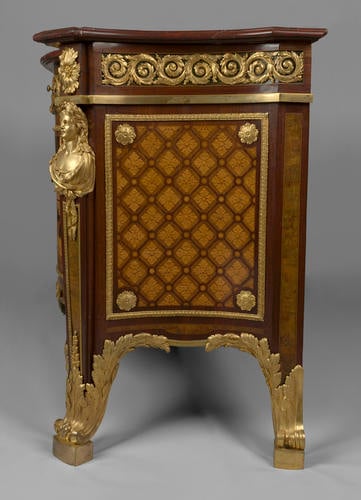
Jean-Henri Riesener (1734-1806)
21213 right side.tif 1774
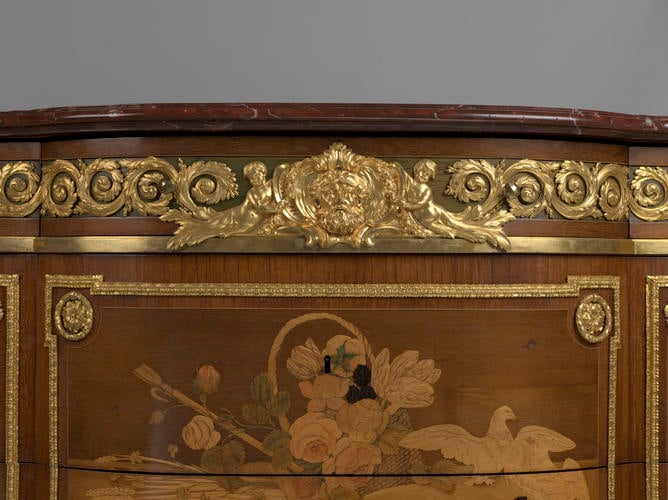
Jean-Henri Riesener (1734-1806)
21213 mount centre top.tif 1774

Jean-Henri Riesener (1734-1806)
21213 mount centre bottom.tif 1774
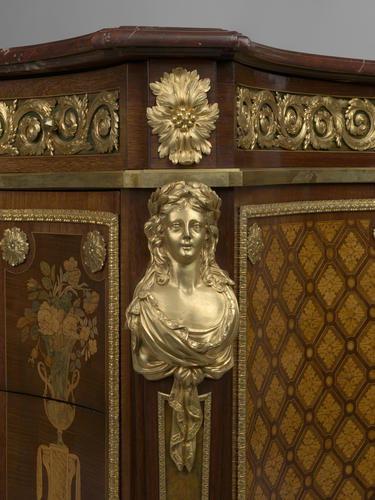
Jean-Henri Riesener (1734-1806)
21213 mount right.tif 1774
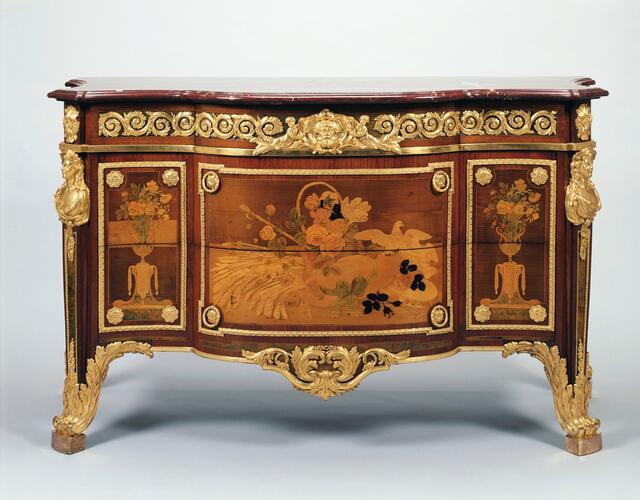
Jean-Henri Riesener (1734-1806)
21213.tif 1774










-
Rectangular commode with curved front, angled corners and red griotte marble top. Two large drawers with large central gilt bronze frame enclosing marquetry panels of a basket of flowers, sheaves of corn, a hat, a shepherd's hoe and two birds; flanked by two smaller gilt bronze frames enclosing marquetry panels of vases of flowers. Gilt bronze arabesque frieze above, centred by the head of Hercules, the frieze with three short drawers. Gilt bronze female caryatids at each front corner. The back panel is painted with Garde Meuble inventory inscription No 2777. Branded on back panel 'VR 1866 WINDSOR CASTLE ROOM NO. 508'.
This chest of drawers, or commode, must have been one of the first pieces of Riesener's official work for Louis XVI. It was ordered for the King's Bedchamber at Versailles shortly after the death of Louis XV in May 1774. After the accession of Louis XVI, Pierre-Elisabeth Fontanieu, who in 1767 had been appointed Indendant et Contrôleur général du Garde-Meuble de la Couronne (Superintendant and Comptroller General of the Royal Furniture Depot), appointed Riesener as ébéniste ordinaire du garde meuble de la couronne, in succession to Gilles Joubert. Riesener's appointment to this valuable position, effectively the King's cabinet-maker or ébéniste du roi, marked a change in direction in the furnishing of the Palace of Versailles. In place of the exuberant rococo commode which stood in the King's Bedchamber for thirty-five years, but on Louis XV's death was claimed as a perquisite of office by the duc d'Aumont, Riesener delivered this restrained neo-classical piece. The old commode, now in The Wallace Collection no F86, was delivered by the cabinet-maker Antoine-Robert Gaudreaus with spectacular gilt bronze mounts by Jacques Caffiéri in 1739. The commission cannot have been given to Riesener before the death of Louis XV, on 10 May 1774, but the commode was delivered on 31 August that year, the day before the court returned. To achieve this, Riesener may have had to use some 'stock' elements, for example partly prefabricated marquetry panels. Elaborate marquetry panels are normally laid onto at least two layers of laminate panels for stability. A number of Riesener's marquetry panels, like those on this cabinet, are laid onto three layers of laminate,suggesting that these marquetry panels were made up ahead of time enabling Riesener's craftsmen to mount panels quickly and efficiently into cabinet-work. The same pre-fabricated method may also hold for some of the gilt bronze mounts.
Riesener's new commode was itself displaced a year later by a considerably more lavish example, also made by Riesener, the commission for which was given in September 1774. This magnificent commode took fourteen months to make and cost the enormous sum of 25,356 livres: it is now in the Musée Condé, Chateau de Chantilly (OA 246). In 1775, then, this commode far from being sent away to a lowly corner of Versailles, was transferred to the Arrière-Cabinet du Roi, a narrow room adjoining the King's Cabinet. However, in 1780 it was moved again to perhaps the most important room at Versailles, the Cabinet Intérieur du Roi, where it joined the King's Desk, made by Riesener's master Oeben and completed and delivered by Riesener in 1769. At this point the original white marble top was changed to the present red griotte d'Italie to harmonise with the existing chimneypiece in that room (with the same edge profile moulding), and a pair of corner cupboards were made to match (RCIN 21212). The ensemble remained in the Cabinet Intérieur until sold in July 1794, lot 15845, which comprised a bureau (unidentified), the commode and the pair of corner cupboards, for the negligible sum of 5,000 livres. They were bought by Jean-Georges Treuttel, the Strasbourg entrepreneur and dealer who bought widely in the Revolutionary sales, including a roll top desk originally made for the comte de Provence, bought by Marceau in the Revolutionary sales, 1793 and subsequently bought by Treuttel (Waddesdon Manor WM 2576). George IV bought this cabinet, the corner cupboards and three other pieces by Riesener in 1825 at the sale of eighty-eight pieces from George Watson Taylor's celebrated collection, for use at Windsor. In 1855 it was recorded in the King's Bed Chamber, used during the State Visit of the Emperor Napoleon III and the Empress Eugénie to Windsor.
Provenance
Louis XVI, made for the King's Bed Chamber, Versailles, 1774; sold to Jean-Georges Treuttel, 1794; George Watson Taylor, his sale Christie's, London, 28 May 1825 lot 58, where bought by Joseph Fogg for George IV (£58 6s).
-
Creator(s)
(cabinet maker)(nationality)Acquirer(s)
-
Medium and techniques
Oak and marquetry, gilt bronze, marble
Measurements
91.0 x 153.0 x 63.0 cm (whole object)
Category
Other number(s)
Laking FR : Laking, G.F., 1905. The Furniture of Windsor Castle, London – Laking FR p133,pl.34